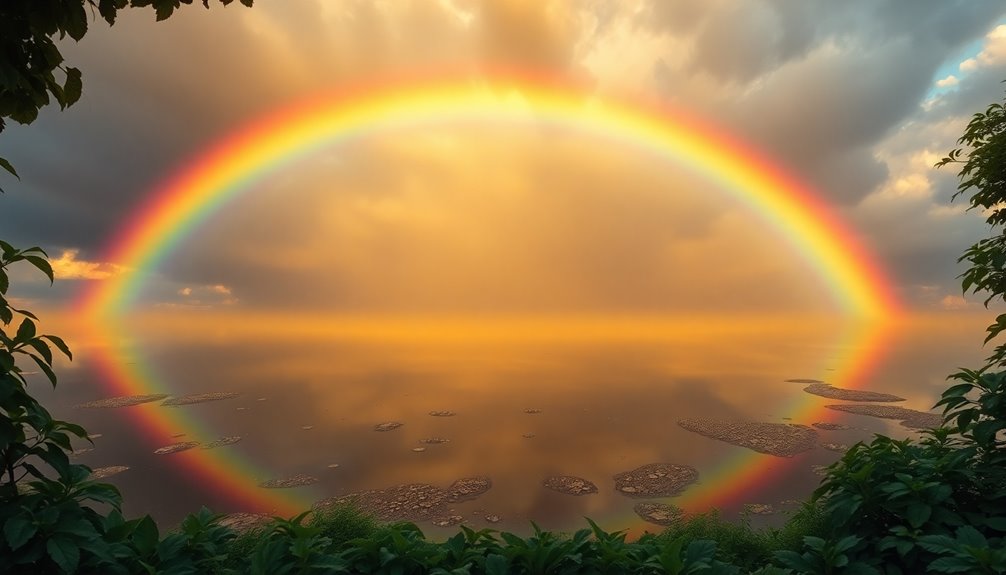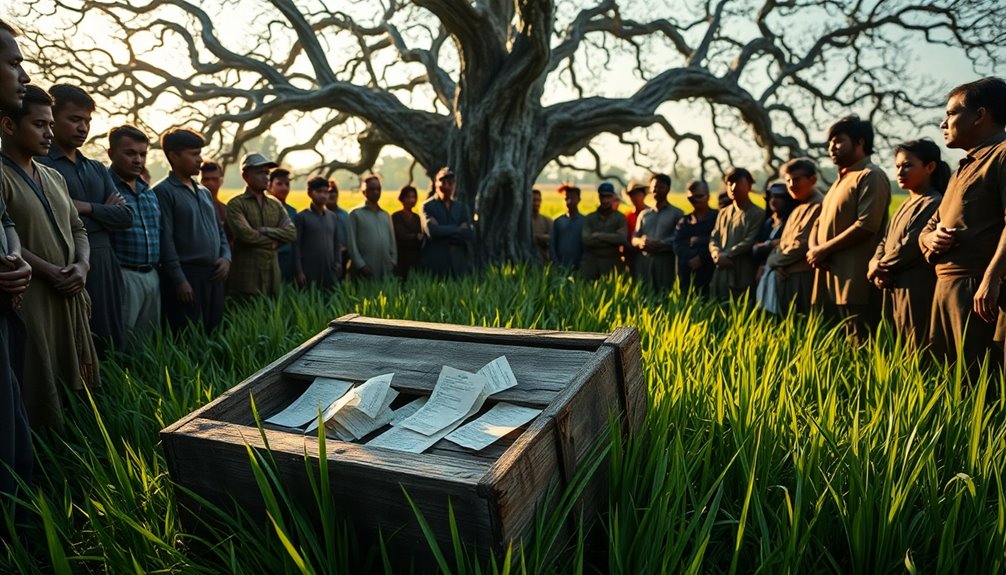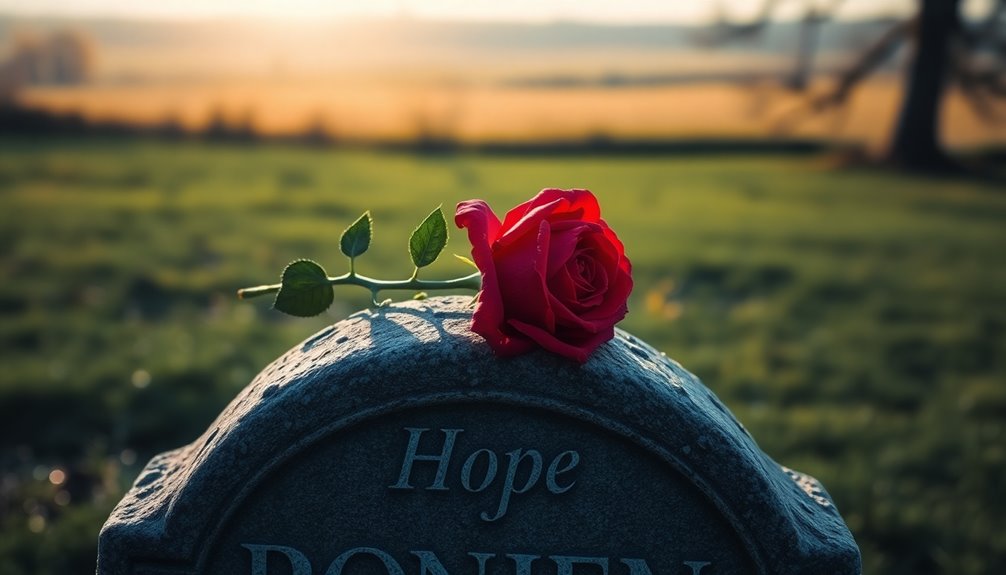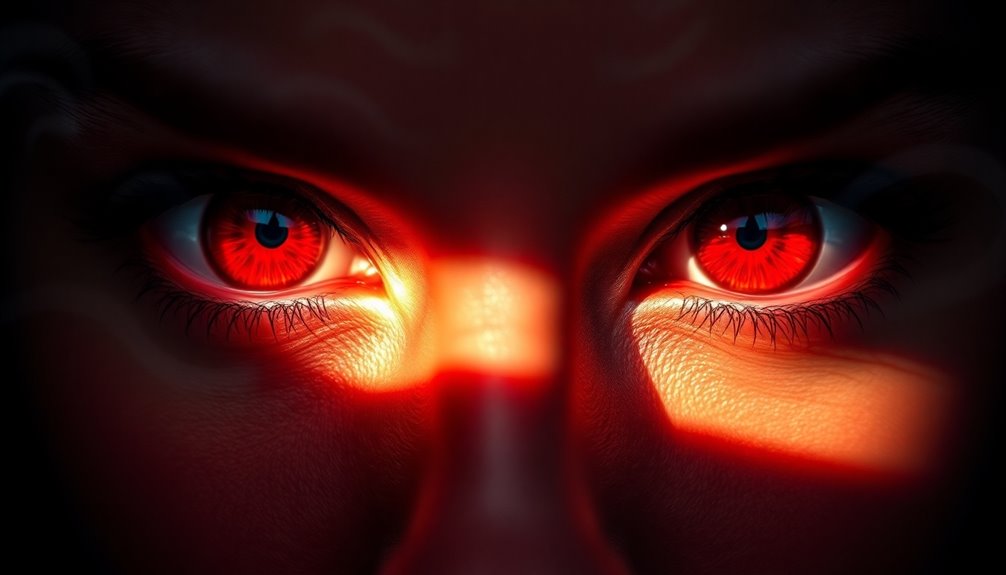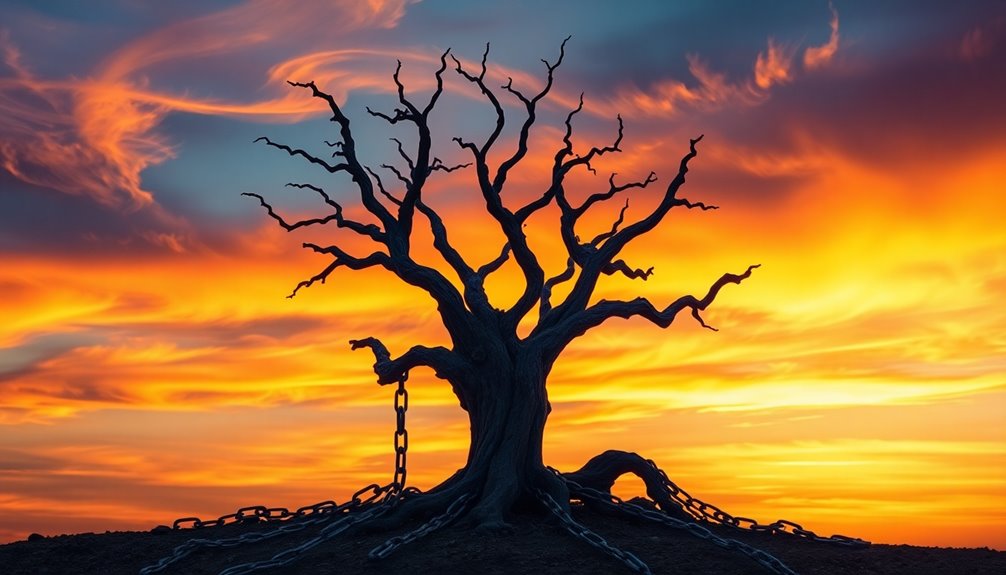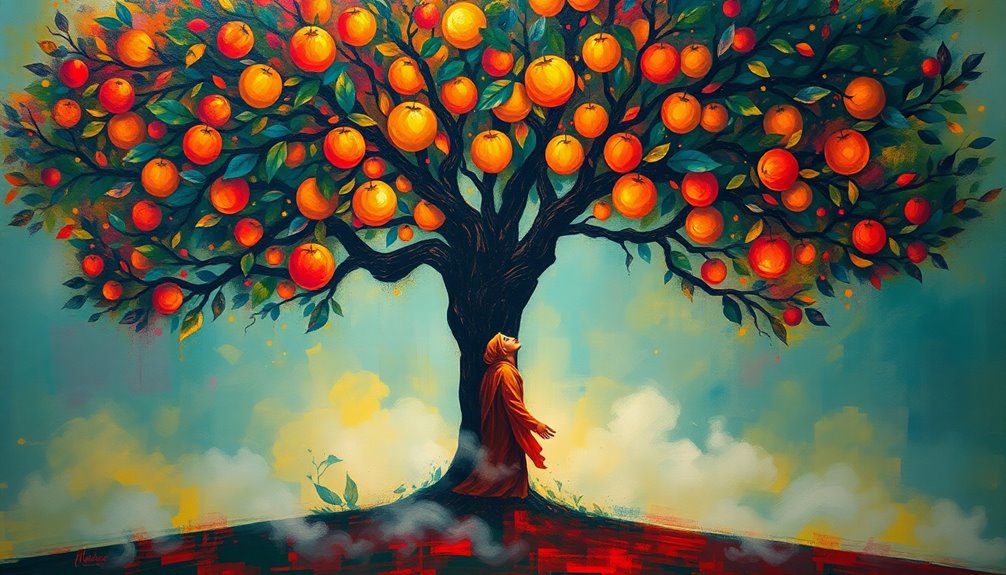Rainbows are magical symbols of hope, connection, and beauty! When you see a rainbow, it reminds you that even after rain, bright days can follow. Each color, like red for passion and yellow for happiness, adds to its meaning. Culturally, rainbows have rich stories from different places. They connect us to nature, symbolize new beginnings, and even show pride in diversity, like the rainbow flag! They encourage optimism and remind us we're not alone. Isn't it exciting to think about all the meanings wrapped up in those stunning colors? There's so much more to discover about them!
Key Takeaways
- Rainbows symbolize hope and new beginnings, representing brighter days after challenges and support from spiritual beings.
- In many cultures, rainbows signify divine promises, such as God's covenant in Christianity and the connection between gods and humanity in Greek mythology.
- The rainbow flag represents LGBTQ+ pride and diversity, with each color symbolizing different aspects of life, promoting inclusivity and acceptance.
- Folklore often associates rainbows with transformation and journeys, such as gender fluidity in Bulgarian beliefs and spiritual pathways in Indigenous cultures.
- Rainbows are seen as reminders of resilience, encouraging optimism and community solidarity, especially during difficult times like the COVID-19 pandemic.
Understanding Rainbows
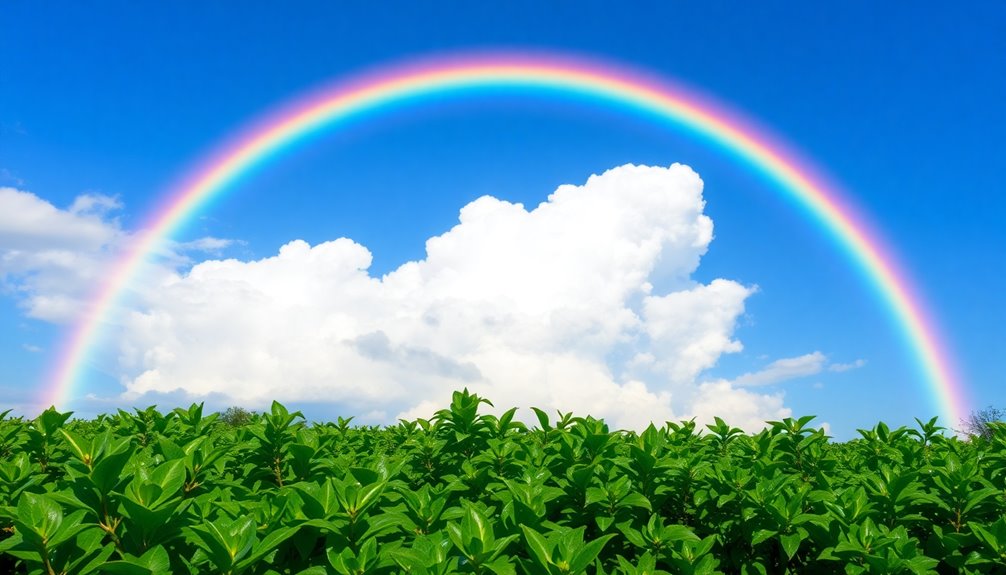
Understanding rainbows can be a fascinating journey into the interplay of light and water. When sunlight shines through raindrops, it bends, reflects, and spreads out. This process creates a beautiful arc of colors in the sky.
You might know that a rainbow has seven colors: red, orange, yellow, green, blue, indigo, and violet. Each color brings its own feelings. For example, red can make you feel passionate and excited, while blue often brings a sense of calm and peace.
Rainbows are more than just pretty sights; they're also symbols of hope. After a rainstorm, when the sun breaks through, a rainbow appears as a reminder of beauty and renewal. It tells us that even after tough times, brighter days can come.
In today's world, rainbows represent solidarity and resilience, especially during challenging times like the COVID-19 pandemic. People have embraced the rainbow as a cheerful symbol of togetherness.
Cultural Significance
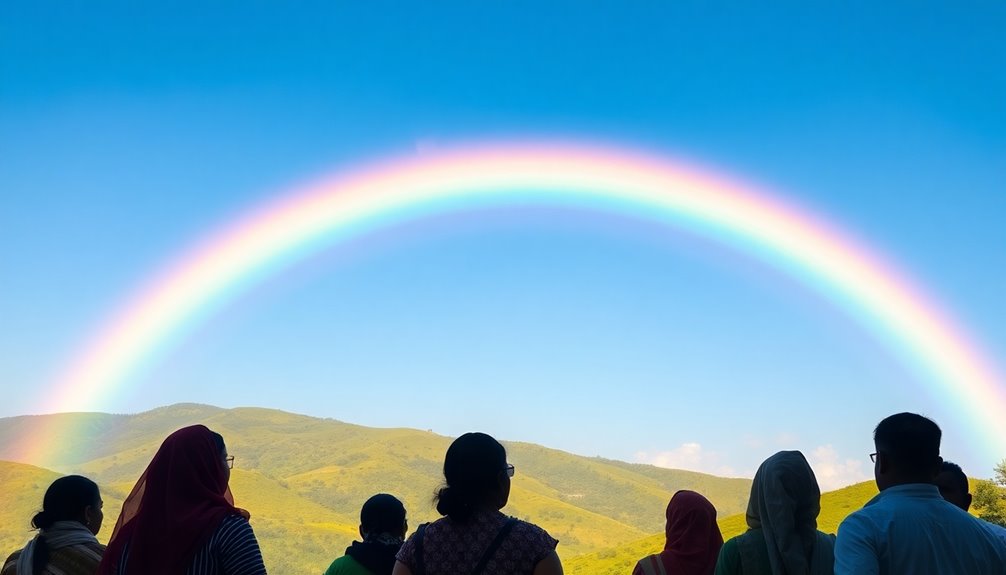
Rainbows carry deep cultural meanings that vary across different societies. In ancient Greek mythology, the rainbow was personified by the messenger goddess Iris. She connected the gods with humanity, symbolizing communication and connection. Isn't that fascinating?
In the Bible, the rainbow appears after Noah's Ark, representing God's promise of protection and hope. It's a beautiful reminder that even after tough times, brighter days can come.
Aboriginal cultures see the Rainbow Serpent as a powerful figure linked to creation and fertility, showing how rainbows play a crucial role in their beliefs.
Meanwhile, in Chinese mythology, the rainbow is a crack in the sky made by the goddess Nüwa. This symbolizes repair and balance in the universe, highlighting its significance in harmony.
Today, the rainbow flag is a vibrant symbol of LGBTQ+ pride, representing diversity and inclusivity. It's a way for people to celebrate who they're and remind everyone of the strength in acceptance.
From ancient stories to modern symbols, rainbows unite us in many beautiful ways! Each culture offers a unique perspective, showcasing how rainbows inspire connection and hope everywhere you look.
Spiritual Meanings

When you see a rainbow, it's like a cheerful message from the universe!
Many believe it signals that your wishes might just come true and that you're getting support from spiritual beings.
This colorful arc can remind you that you're not alone on your journey and that new beginnings are always possible.
Divine Communication Signs
Throughout history, many cultures have seen rainbows as powerful signs of divine communication. When you catch a glimpse of a rainbow, it's like a beautiful message from the universe! In Judeo-Christian traditions, rainbows symbolize God's promise to humanity after the flood, reminding you that hope always follows struggle.
Many believe that rainbows also signify the presence of guardian angels, especially during tough times. These vibrant arcs in the sky can feel like a comforting hug from above, letting you know you're not alone.
In different cultures, rainbows serve as bridges connecting the earthly domain to the divine, creating pathways for spiritual guidance. The goddess of love and beauty is often linked to these colorful sights, further emphasizing their enchanting nature.
Each color in a rainbow represents various spiritual energies and emotions, acting as reminders of divine support in your journey. When you see a rainbow, think of it as a joyful sign, encouraging you to embrace your path and stay open to the messages around you.
Fulfillment of Wishes
A vibrant arc of colors often signals that wishes may soon come true, filling your heart with hope and positivity. When you spot a rainbow, it's like a gentle reminder that the fulfillment of wishes is within reach. This beautiful phenomenon inspires you to keep dreaming and pursuing your goals with joy and enthusiasm.
Many cultures see rainbows as symbols of dreams realized. They encourage you to stay focused and keep pushing forward, even when things get tough. It's as if the universe is giving you a motivational nudge, telling you that divine support is right there with you. You're not alone on your journey!
Seeing a rainbow can also feel like a special sign from angels, showing their approval of your current life path. This connection between earthly experiences and spiritual dimensions brings comfort during challenging times.
You can trust that you have the strength to overcome obstacles, as a rainbow reminds you of the magic surrounding your wishes.
Guidance and Support
Rainbows serve as powerful symbols of guidance and support, reminding you that divine assistance is always within reach. Whenever you see a rainbow, it's like a gentle nudge from the universe, telling you that you're not alone. This colorful arc brings hope during tough times, suggesting that brighter days are ahead.
In many cultures, rainbows are seen as messages from the spiritual dimension, offering reassurance from loved ones who have passed away. They symbolize a connection between your earthly struggles and the divine guidance available to you.
Here's a quick look at the meanings behind rainbows:
| Symbolism | Meaning |
|---|---|
| Guidance | Support from angels during challenges |
| Hope | A reminder to keep pursuing your dreams |
| Spiritual Connection | Link between earthly experiences and divine help |
| Reassurance | Messages from loved ones in the spiritual dimension |
Colors and Their Symbolism
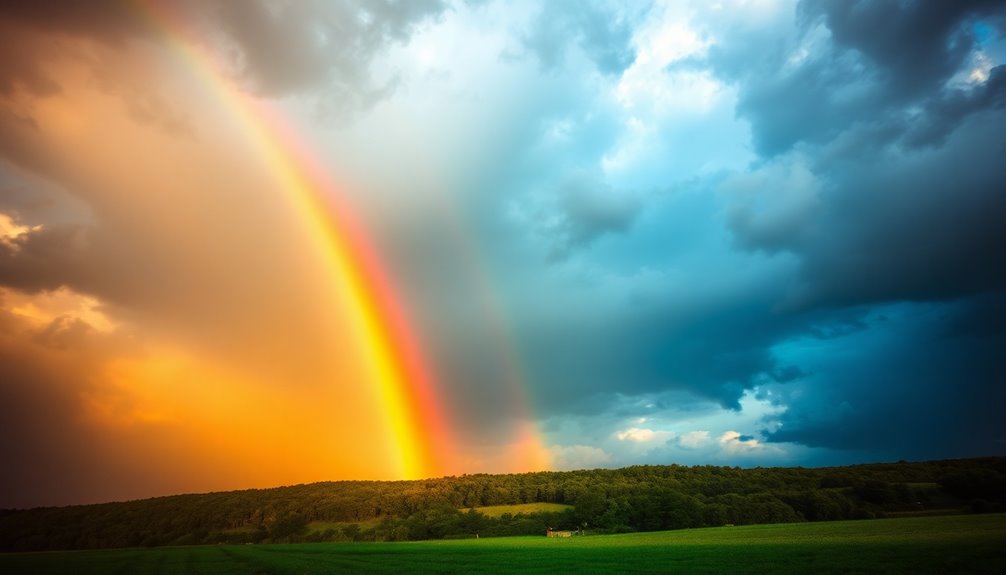
Colors in a rainbow each carry their own unique symbolism that resonates with different emotions and feelings. When you look at a rainbow, you're seeing a beautiful blend of colors, each telling a story.
- Red symbolizes passion and liveliness, sparking strong emotions and energy.
- Orange represents endurance and perseverance, filling you with warmth and enthusiasm.
- Yellow is linked to happiness and cheer, making you feel joyful and optimistic.
One of the most important colors is green. It signifies growth and renewal, reflecting nature's vibrancy.
When you think of green, you might picture fresh grass or budding leaves, reminding you of new beginnings and the promise of life.
Each color plays a special role in the rainbow, helping you connect with your feelings and the world around you.
Historical Perspectives
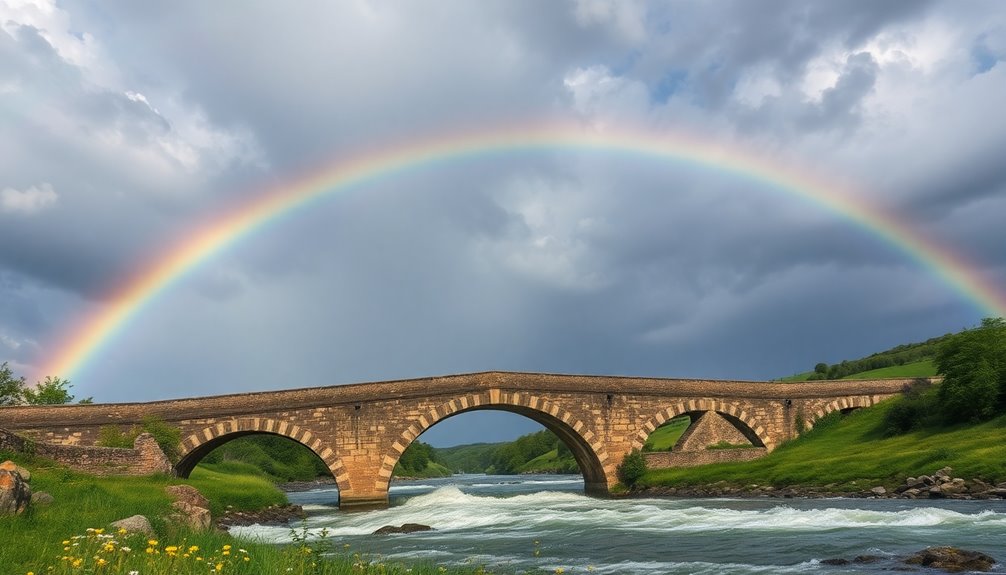
Throughout history, the symbolism of rainbows has sparked fascination and wonder across cultures. When the first rainbow appears after a storm, it often brings hope and joy. In the Bible, the rainbow is a sign of the covenant God made with Noah, promising never to flood the Earth again. This story shows the rainbow as a beautiful reminder of divine promise.
Other cultures view rainbows differently. In ancient Greek mythology, Iris, the goddess of the rainbow, connects gods and humans, symbolizing communication. Norse mythology describes Bifröst, a rainbow bridge that links the domains of gods and people, emphasizing accessibility to the divine. Yet, in MesoAmerican cultures, rainbows were seen as bad omens, leading to protective actions.
Here's a quick look at some perspectives:
| Culture | Rainbow Symbolism |
|---|---|
| Biblical | Sign of the covenant |
| Greek | Messenger between gods and humans |
| Norse | Bridge connecting domains |
| MesoAmerican | Bad omen |
These interpretations highlight how the rainbow appears differently across various cultures, showcasing its rich historical significance. Isn't that fascinating?
Rainbows in Folklore
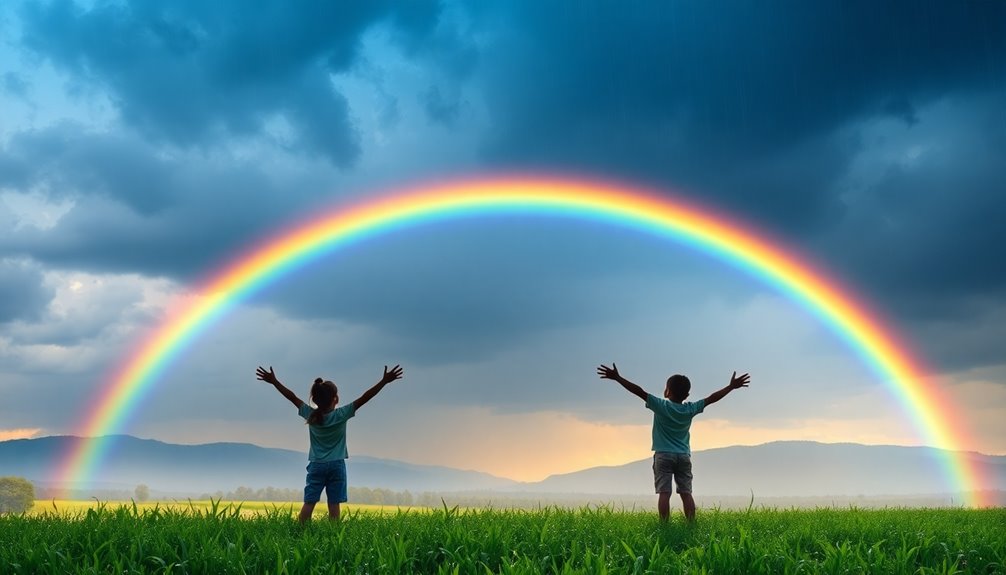
While many cultures celebrate the beauty of rainbows, their meanings in folklore can vary dramatically. You might be surprised to learn that rainbows can symbolize everything from transformation to divine connections! In Bulgarian folklore, for instance, walking under a rainbow is believed to change a person's gender, highlighting the ideas of fluidity and change.
Here are some fascinating aspects of rainbows in different cultures:
- The ancient Greeks and Romans saw them as the goddess Iris, the mother goddess who delivered messages from the gods.
- In Norse mythology, rainbows represent Bifröst, the rainbow bridge connecting the domains of gods and humans.
- Indigenous beliefs often view rainbows as pathways to the spiritual domain, signifying journeys between different planes of existence.
In Irish legend, rainbows often symbolize hope and promise, appearing after storms as a reminder of brighter days ahead.
Some cultures, however, see rainbows as bad omens, associating them with misfortune. This shows just how rich and varied the symbolism of rainbows can be in folklore, inviting you to explore their meanings further!
Modern Expressions

Rainbows have evolved beyond their folkloric roots to become powerful symbols in modern society. They represent much more than just colors in the sky. One of the most famous symbols is the rainbow flag, created by Gilbert Baker in 1978. This flag stands for Gay Pride, celebrating diversity and acceptance in the LGBTQ+ community. It shows that love is love, no matter who you are!
During the COVID-19 pandemic, people around the world got creative and displayed homemade rainbow images in their windows. These colorful drawings became symbols of hope and community solidarity while everyone practiced social distancing.
Rainbows also pop up in digital art and memes, spreading positivity and resilience. They remind us to stay strong, even during tough times.
Moreover, the imagery of rainbows is often used in social movements and activism. It encourages inclusivity and unity, showing that together, we can overcome challenges.
Even the concept of the "Rainbow Bridge" comforts pet owners, symbolizing hope to reunite with their beloved pets one day. In all these ways, rainbows today inspire joy, strength, and connection.
Rainbows and Hope
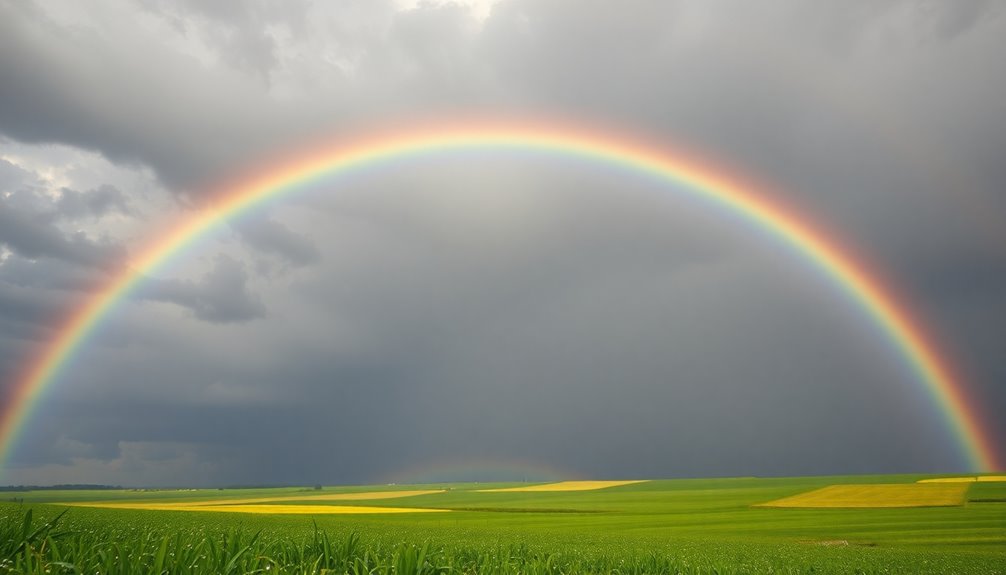
Rainbows are like a magical promise of hope, showing us that brighter days are ahead after tough times.
Different cultures see them as special signs connecting us to something greater, reminding us that we can be resilient.
Just think about how rainbows brought us together during the pandemic, sparking creativity and joy in our communities!
Cultural Interpretations of Hope
Throughout history, cultures around the world have looked to rainbows as powerful symbols of hope. After tough times, these colorful arcs remind us that brighter days are ahead. For instance, in the biblical story of Noah, the rainbow represents God's promise to humanity, assuring us that there won't be another great flood. This idea of renewal is found in many traditions.
Here are a few ways rainbows symbolize hope across cultures:
- In Christianity, they signify mercy and protection from God.
- Indigenous beliefs see rainbows as bridges to the spiritual world, offering guidance.
- The rainbow flag represents love and acceptance in the LGBTQ+ community, celebrating diversity and hope for equality.
Rainbows carry a special meaning, especially during challenging times like the COVID-19 pandemic, when communities displayed handmade rainbows to spread optimism and support.
They remind us that after storms, we can find beauty and light. So, whenever you spot a rainbow, remember it's not just a pretty sight; it's a powerful symbol of hope, linking us to countless stories of resilience and promise throughout history.
Modern Symbols of Resilience
A vibrant spectrum of colors has emerged as a modern emblem of resilience and hope, especially in times of adversity. During the COVID-19 pandemic, rainbows appeared in windows, drawing smiles and lifting spirits. Families created handmade rainbow drawings, showcasing their creativity while fostering a sense of community.
This beautiful trend began in Italy, where children crafted colorful art that quickly spread around the world as a sign of solidarity. Rainbows became symbols of strength, showing that together, we can overcome challenges. They remind us of the power of acceptance and diversity, encouraging everyone to unite.
Each time you see a rainbow, think of it as a sign of defiance against tough times. It represents the support and encouragement we can share with one another. Even today, rainbows spark feelings of optimism, promising brighter days ahead.
They resonate with people of all ages and backgrounds, highlighting our shared experiences. Whether you're a child or an adult, the image of a rainbow can inspire you, reminding you that resilience is alive in every community. So, let's embrace these colorful symbols of hope!
The Rainbow Flag

Emerging from the vibrant spirit of the LGBTQ+ community, the rainbow flag has become a powerful emblem of pride and diversity since its debut in 1978. Created by artist Gilbert Baker, this flag first flew in San Francisco during Gay Pride Day. Each color holds a special meaning, representing life, healing, sunlight, nature, magic, serenity, and spirit.
Today, the rainbow flag stands for hope and inclusivity, reminding everyone that love and acceptance are essential. You might see it flying high at pride parades or displayed in art and fashion. It's a symbol that unites people across the world.
Here are some key points about the rainbow flag:
- Diverse Colors: Each hue symbolizes different aspects of life and identity.
- Universal Recognition: The flag is widely recognized and celebrated in many cultures.
- Evolving Design: New variations, like adding black and brown stripes, highlight the importance of all communities.
When you see the rainbow flag, remember it's more than just colors. It's a message of hope and a celebration of diversity that encourages everyone to be proud of who they are!
Frequently Asked Questions
What Does a Rainbow Represent?
A rainbow represents hope, joy, and connection. You might see one after a rainstorm, reminding you that beauty can follow tough times.
It's often linked to good luck, like in Irish tales of leprechauns and pots of gold. In many cultures, rainbows connect the earth to the divine, showing that magic exists in everyday life.
What Does God Say About Rainbows?
God's words about rainbows are like a burst of joy after a storm! He uses rainbows to remind us of His promises.
In the Bible, God tells Noah that the rainbow is a sign of His covenant, a beautiful reminder that He won't flood the earth again.
It's not just pretty colors; it represents His mercy and love for us.
Every time you see one, remember how special that promise is!
What Does the Rainbow 🌈 Mean?
When you see a rainbow, it's like a colorful hug from nature! It often appears after rain, reminding you that brighter days are ahead.
Each of the seven colors—red, orange, yellow, green, blue, indigo, and violet—can make you feel different emotions. In many cultures, rainbows symbolize hope, connection, and even promises.
What Is the Spiritual Lesson of the Rainbow?
The spiritual lesson of the rainbow reminds you to embrace hope and renewal.
When life gets tough, the rainbow encourages you to look for brighter days ahead. Each color represents something special, like growth and peace.
It's a sign that you're never alone; there's a divine presence guiding you.
Conclusion
To sum up, rainbows are like a bridge connecting our hearts and dreams. They remind us of hope, joy, and the beauty of diversity. Whether in stories, cultures, or our daily lives, rainbows inspire us to look for the good even after the storm. So, the next time you see one, take a moment to appreciate its vibrant colors and what they symbolize. Embrace the magic of rainbows, and let them fill your world with happiness!

